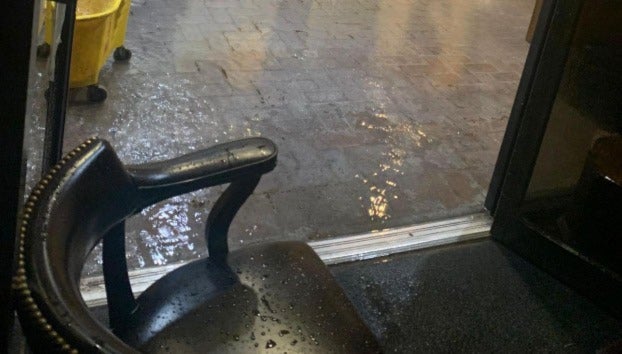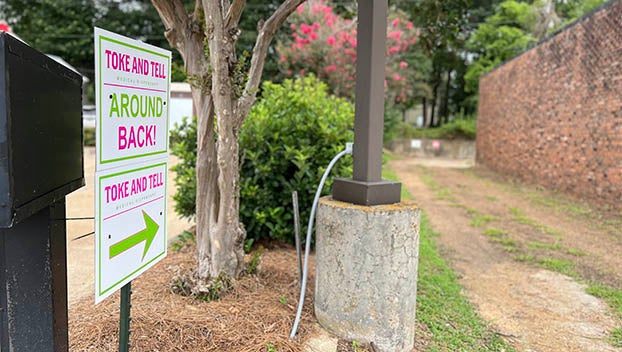Experience from 2011 pays off for current flood fight
Published 12:00 am Sunday, January 17, 2016

In 2011, officials on both sides of the Mississippi River were experiencing a historic flood for the first time. Armed with lessons from the 2011 flood, officials and residents acted with calm and confidence to this year’s flood. At top, waters surrounded the Vidalia Conference and Convention Center protected by Hesco baskets filled with sand in 2011. This year, at bottom, officials used the same Hesco baskets in a different configuration to not only protect the buildings on the riverfront but also the roadways to allow riverfront businesses to remain open. (File photos)
NATCHEZ — When floodwater predictions began to rise for the Mississippi River in December, placing it close to the level that submerged the Vidalia riverfront in 2011, officials assured residents that the lessons of the historic flood would not be forgotten.
Since then, the initial projection that the river would reach 60 feet today has been lowered, with the crest reaching to only 56.5 feet on the Natchez river gauge.
But at the time, minds immediately jumped back to the most recent significant high water event.
When the news first came in, Ward 1 Alderwoman Joyce Arceneaux-Mathis had just stepped into the position of mayor pro tem when Natchez Mayor Butch Brown was admitted to the hospital after sustaining two strokes.
Upon hearing the news, Arceneaux-Mathis had one immediate reaction.
“The mayor was in the hospital and on top of that the water was rising,” Arceneaux-Mathis said.
Like many other officials who were in office in 2011, the flood is still clear in Arceneaux-Mathis’ memory. That year, the river rose to 61.95 feet, washing away the 1937 record.
Vidalia Mayor Hyram Copeland said it was the kind of flood people usually only see once in 500 years.
“It was an unknown,” Copeland said. “We didn’t know what was going to happen.”
Project Manager with Bryant Hammett & Associates, LLC. Guy Murray, the firm that handles engineering services for Vidalia, said the engineers and others were addressing issues as they came up and learning as they went in 2011.
But, this time, they had more time to prepare, and more experience, Murray said.
“What we did in 2015 and 2016 was capitalize on what we did well in 2011 and learn from our mistakes and try to address those this time,” he said.
With a flood fight in recent memory, people were able to mobilize faster because they knew what they needed to have in place, Public Affairs Specialist with the U.S. Army Corps of Engineers Mike Petersen said.
People were more familiar with the officials on all levels of government, he said.
And as officials responded to the 2015 and 2016 predictions, several stressed the high level of cooperation between the different parties involved, including the U.S. Army Corps of Engineers, the National Guard and city departments.
“With everyone working together and communicating with each other it worked like clockwork,” Copeland said.
Familiarity also played into Arceneaux-Mathis’ reaction over the past few weeks.
During the 2011 flood, she visited places in Ward 1 that were affected.
Those areas stayed in her mind nearly five years later.
“I knew the people down there, so I knew where to go and what to expect,” Arceneaux-Mathis said.
She wasn’t the only one traveling in 2011. Fifth Louisiana Levee District President Reynold Minsky traveled to Ferriday, Oak Grove and other cities in the district for town hall meetings to try and calm residents’ fears.
“We didn’t have to do that this year,” Minsky said. “The people were really calm.”
Although Minsky has had to deal with some rumors, he thinks that after people’s experience in 2011 and how the flood was handled people trust them enough and won’t get upset until they tell them there’s a problem.
He’s not alone.
“A lot of people get comfortable,” Petersen said. “They see us handle the highest flood on record, and they have a lot of confidence in us.”
Another big difference was the sand boils. In 2011, Minsky said the district experienced several along the levees, which took hours of work to contain. Sand boils are areas in which water from the flooded river finds a way beneath the levee and springs from the ground. Left uncorrected, they can lead to the undermining of a levee.
“This year it’s just been kind of a breeze,” Minsky said.
There have been fewer boils this year, and that’s not an accident. In the years following the flood, Petersen said 15 miles of levees have been raised, 150 relief wells installed and 4.5 miles of seepage berms added to the Vidalia-Natchez area.
Seepage berms are an earthen blanket built on top of an area. The weight prevents the seepage from cropping up too close to the levee, Petersen said, while relief wells help water move without taking soil with it.
But one thing from 2011 has stayed the same — the use of Hesco baskets.
This time, however, they’re being used differently. During 2011, the baskets were placed around each individual building on the riverfront instead of strategically placing them to protect the entire riverfront area.
In 2011, the Hesco baskets were an experiment borne of expediency, Murray said.
“None of us had ever heard of Hesco much less used it, so we had our doubts,” Murray said. “We were on the learning curve with all of it.”
One side effect of the approach to ringing each business with baskets was that no one could access the businesses, Copeland said, because the water was on the roads.
This year, the city planned to put the Hesco baskets around the riverfront’s perimeter, allowing businesses to stay open and continue to operate.
But, at least for now, many preparations remain just that — preparations. Instead of rising to 60 feet, the predicted crest was 56.5 on Saturday, a level the river is expected to maintain this morning.
It’s still well above the 48 feet flood stage level though.
“With the crest imminent, we’re not letting up,” Petersen said Friday.
And even after Sunday the area may not be quite out of the woods.
Minsky said he is worried spring rains might create problems further down the road.
Until then, Petersen they’ll be keeping an eye on things, making sure the levees are in good condition after the recent rise in water level, since every flood takes a toll on them.
“We’ll do everything we can to be ready,” Petersen said.





